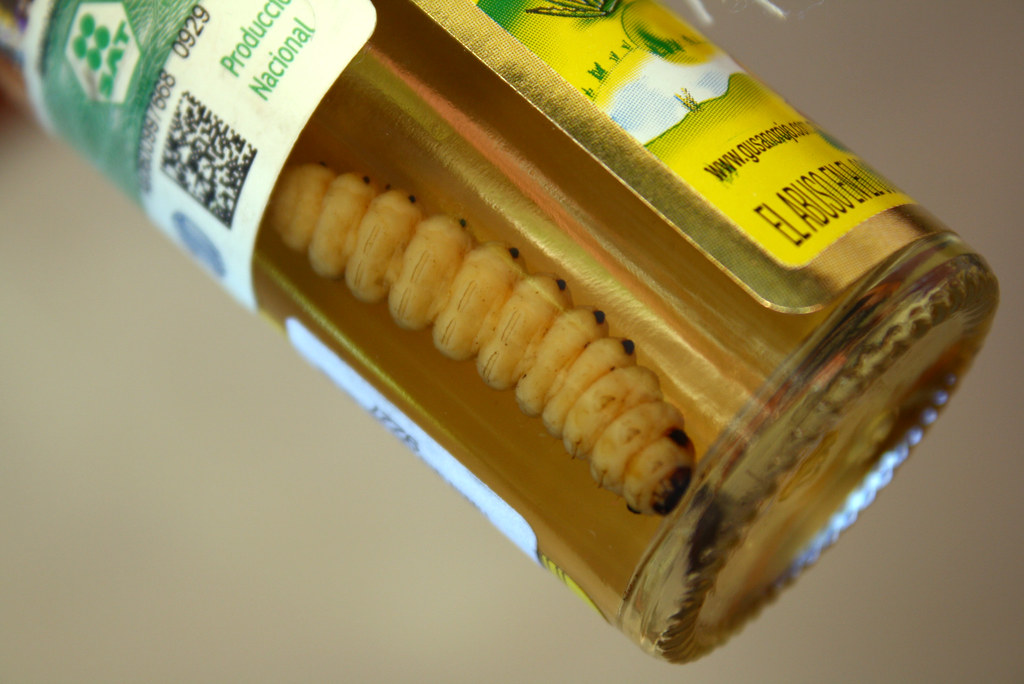
The tequila worm, also known as the gusano, is a worm that is often found in bottles of mezcal, a type of agave-based liquor. The worm is usually added to the bottle during the production process and is believed to have been included as a marketing ploy to entice adventurous drinkers. However, the question remains: can you eat the tequila worm?
Table of Contents
Tequila Worm Origins
Tequila is a distilled alcoholic beverage made from the blue agave plant, primarily grown in the area surrounding the city of Tequila, 65 km (40 mi) northwest of Guadalajara, and in the Jaliscan Highlands (Los Altos de Jalisco) of the central western Mexican state of Jalisco. The tequila worm, also known as the gusano, is a creature that can be found in some bottles of tequila. However, its origins and significance are widely debated.
History of the Tequila Worm
The history of the tequila worm is shrouded in mystery. Some sources claim that the worm was originally used as a marketing gimmick in the 1940s to differentiate tequila from other spirits. Others say that the worm was added to tequila bottles as a way to prove the alcohol content. According to this theory, the worm would die if the alcohol content was too low.
Another theory suggests that the tequila worm has been used for centuries as a natural aphrodisiac. This theory is based on the fact that the worm is rich in protein and other nutrients that are believed to enhance sexual performance.
 photo credit: live.staticflickr.com
photo credit: live.staticflickr.com
Edibility of the Tequila Worm
The tequila worm, also known as the gusano, is a type of caterpillar that is often found in bottles of mezcal. While it is not traditionally found in tequila, some brands have started adding it as a marketing gimmick. But can you actually eat the tequila worm? Let’s find out.
Safety Considerations
First and foremost, it is important to note that the tequila worm is not toxic. However, it is not recommended to eat it raw due to the risk of bacterial infections. The worm is usually preserved in alcohol, which helps kill any bacteria that may be present. Therefore, it is recommended to consume the worm only if it has been properly cooked or soaked in alcohol.
Additionally, some people may have an allergic reaction to the tequila worm. Those who are allergic to shellfish, in particular, may also be allergic to the worm, as they are both arthropods. It is important to be aware of any allergies before consuming the worm.
Nutritional Aspects
While the tequila worm may not be the most appetizing thing to eat, it does have some nutritional value. The worm is high in protein and contains some essential amino acids. It is also a good source of fiber, which can help promote digestive health.
However, it is worth noting that the tequila worm is not a significant source of any particular nutrient. Therefore, it should not be consumed solely for its nutritional value.
Consumption Rituals
Tequila with a worm is a tradition that has been around for centuries. The worm, also known as the “gusano,” is the larvae of the Hypopta agavis moth that lives on the agave plant, which is used to make tequila. The worm is usually found at the bottom of a bottle of mezcal, a type of tequila made from the agave plant.
Traditional Rituals
In traditional Mexican culture, eating the worm is considered a rite of passage. It is believed that the worm has mystical and healing properties that can cure various ailments. The worm is also believed to enhance the flavor of the tequila and make it smoother.
To consume the worm, it is usually eaten after finishing the bottle of mezcal, either by taking a bite directly or incorporating it into another dish. Some people prefer to eat the worm with salt and lime, while others prefer to eat it with chili powder.
Contemporary Trends
In recent years, the tradition of eating the worm has become less popular. Many tequila producers have stopped including the worm in their bottles, and some even consider it a marketing gimmick. However, some people still enjoy the tradition and believe that eating the worm is an essential part of the tequila experience.
In contemporary times, people have started to incorporate the worm into other dishes, such as tacos and guacamole. Some even use the worm as a topping for pizza. Additionally, some people have started to use the worm as a garnish for cocktails.
Common Misconceptions
There are several misconceptions surrounding the tequila worm, which can lead to confusion about whether it is safe to eat. Here are some of the most common misconceptions:
The Tequila Worm is a Traditional Part of Tequila
Contrary to popular belief, the tequila worm is not a traditional part of tequila. In fact, it is not even found in most tequilas. The worm is actually a marketing gimmick that was invented in the 1940s to help promote a brand of mezcal. While some mezcals do contain a worm, it is not a traditional part of the drink.
Eating the Tequila Worm Will Make You Hallucinate
Another common misconception is that eating the tequila worm will make you hallucinate. This is simply not true. While some people may experience mild hallucinations after consuming large amounts of mezcal, these effects are not caused by the worm. In fact, the worm is not even a psychoactive substance.
The Tequila Worm is Harmful to Eat
Many people believe that the tequila worm is harmful to eat, but this is not true. The worm is actually a type of caterpillar that feeds on the agave plant. It is completely safe to eat, although it may not be very appetizing. Some people even consider it a delicacy.
The Tequila Worm is a Sign of High-Quality Mezcal
Finally, some people believe that the tequila worm is a sign of high-quality mezcal. While it is true that some high-quality mezcals contain a worm, this is not always the case. The presence of a worm is more likely to be a marketing gimmick than a sign of quality. In fact, some of the best mezcals in the world do not contain worms.
Legal and Regulatory Aspects
According to the Normas Oficiales Mexicanas (the Mexican Standards Authority), it is not permissible to use insects or larvae in tequila. However, this regulation applies only to tequila, not mezcal. As per Mexican law, mezcal can contain a worm, which is usually a larva of the Hypopta agavis moth.
It is important to note that not all mezcal bottles contain worms. The presence of a worm is entirely up to the producer’s discretion. Moreover, the worm is not an essential component of mezcal production, and its absence does not affect the quality or authenticity of mezcal.
It is also worth mentioning that the worm does not have any significant impact on the flavor or aroma of mezcal. In fact, some argue that the worm is added to mezcal bottles to create a unique selling point rather than enhance the drink’s taste.
Frequently Asked Questions
What effects does consuming the worm in mezcal have on the body?
There is no scientific evidence to suggest that consuming the worm found in some bottles of mezcal has any positive or negative effects on the human body. Some people believe that the worm can increase the alcohol content of the drink, but this is not true. In fact, the worm is added to the bottle after the mezcal has been distilled.
Is there any truth to the belief that the tequila worm has hallucinogenic properties?
No, there is no truth to the belief that the tequila worm has hallucinogenic properties. This is a myth that has been perpetuated for many years. The worm found in some bottles of mezcal is actually the larva of the Hypopta agavis moth, and it is added to the bottle as a marketing gimmick.
What is the significance of the worm found in some bottles of mezcal or tequila?
The worm found in some bottles of mezcal or tequila is a marketing gimmick that originated in the 1940s. The worm is actually the larva of the Hypopta agavis moth, and it is added to the bottle as a way to differentiate the brand from others. Some people believe that the worm is a symbol of good luck, while others believe that it is a sign of quality.
How does the presence of a worm in the bottle impact the price of tequila?
The presence of a worm in the bottle does not necessarily impact the price of tequila. The price of tequila is determined by a variety of factors, including the quality of the agave used to make the tequila, the distillation process, and the aging process. While some brands of tequila that contain worms may be more expensive than others, this is not always the case.
Are there any notable differences between the maguey worm and the mealworm in alcoholic beverages?
Yes, there are notable differences between the maguey worm and the mealworm in alcoholic beverages. The maguey worm is the larva of the Hypopta agavis moth, and it is found in some bottles of mezcal and tequila. The mealworm, on the other hand, is a type of beetle larva that is sometimes used in other types of alcoholic beverages. While both types of larvae are edible, they have different flavors and textures.
Conclusion
Although the worm is commonly associated with tequila, it is actually found in mezcal, a distilled alcoholic beverage made from the agave plant. The worm, also known as the gusano de maguey, is the larva of the Hypopta agavis moth, which feeds on the agave plant.
While some people may enjoy the taste of the worm, others find it unappetizing. It is often eaten after finishing the bottle of mezcal, either by taking a bite directly or incorporating it into another dish. Mexican chefs often incorporate fried gusano de maguey into dishes, and it makes for a great drinking snack alongside tequila.
Related Posts
If you enjoyed learning about tequila worms, you might be interested in reading more about other topics related to the world of spirits. Here are some articles from The Whisky Lady that you might find interesting:
- Jane Walker: good or bad idea?: This article discusses the pros and cons of Diageo’s decision to launch a female version of their Johnnie Walker brand.
- There’s no “best whisky in the world”: This article challenges the notion that there is a definitive “best” whisky in the world and encourages readers to explore a variety of options.
- The rebirth of silent distilleries: am I excited?: This article explores the trend of reviving old, “sleeping” distilleries and considers the potential benefits and drawbacks of these efforts.
- No, good whisky isn’t too expensive!: This article addresses the common complaint that whisky is too expensive and provides some tips for finding high-quality options at reasonable prices.
- A practical guide to cask finishing: This article provides an overview of cask finishing, a process that involves aging whisky in a secondary barrel after it has already been aged in its primary barrel.



